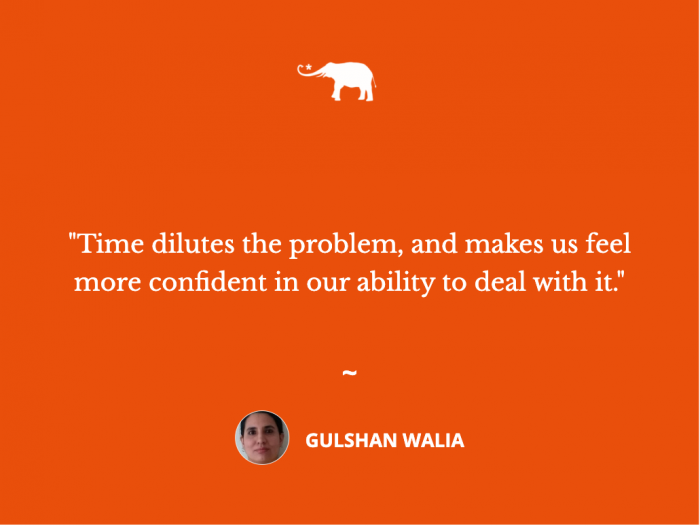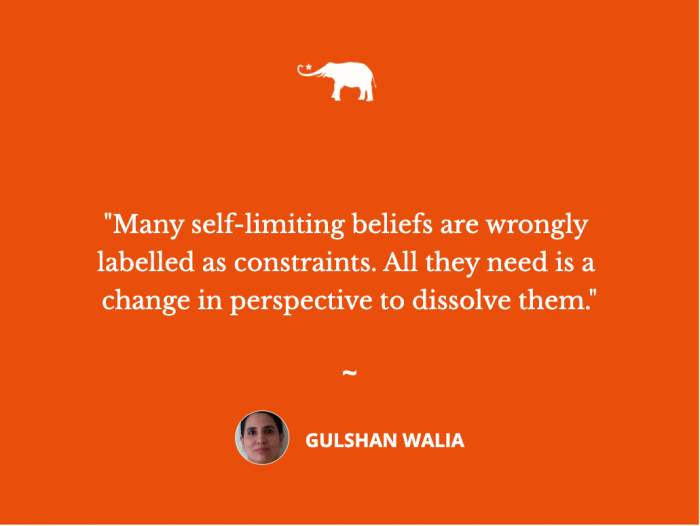Have you ever spilled gravy on your clothes?
It creates a dark stain, and we often soak the stain in water to clean it. The water dissolves the stain to some extent, reducing and weakening it, leaving only its tough part behind, which also becomes easier to remove as it is softened by water.
What if we were to apply this principle of “dissolving” to our problems? How can we dissolve problems in order to weaken and reduce them in intensity? And which are the solvents that can help dissolve our problems?
Time.
Time is one of the greatest solvents available to us, and it is incredibly powerful in healing both physical and psychological wounds. Time revives the sinking heart, stabilizes trembling limbs, and sharpens the numbed mind. Many problems seem easier to deal with, once some time has elapsed from their initial onslaught, or you have “slept over them.”
The phrase “sleep over it” is simply a technique to allow our initial, panicky reactions to subside by giving ourselves time to recover. The problem may still exist, but it doesn’t appear as large and burdensome as it did earlier.
Time dilutes the problem and makes us feel more confident in our ability to deal with it.
A second way of using time as a solvent to dissolve problems is to ask the question, “Will this matter a year from now?” Problems like a long queue at the shopping counter, a tear in our shirt, or a traffic jam can bring about such heated reactions from us, as if someone has cheated us of a million dollars. We blow these issues out of proportion due to our lack of patience and tolerance and end up wasting precious time and energy on them. Many of these issues won’t matter within a month from now, what to say about whether they will matter in a year from now.
When evaluated against the template of time, these issues dissolve and become just another irrelevant detail of our life.
1. Think about the last six months, can you identify issues that you blew out of proportion, but that really won’t matter to you in a year from now?
2. How will you deal with them the next time they arise, and conserve your time and energy for more constructive pursuits?
A third way of using time as a solvent is for problems that only time can dissolve. They don’t need any active intervention from our end.
A mother fretting that her child is not walking at one year of age, in spite of the doctor reassuring her that his health indicators are normal. There is no specific intervention needed from her end, except to be patient and allow time to help the child gain strength and develop balance. Time is the only solution in this case.
Sometimes, time is the solution for many relationship problems as well. A partner or friend has wronged us, and we can actively take it up with them or wait for them to “come around.” At times, waiting for people to “come around” is a good solution. Again, no active intervention is needed from our end, we just have to give people the time to introspect their own behavior and make amends.
It may not work always, but in my experience, I have seen that many people, including children, who are able to introspect given the benefit of time, and do “come around.”
New and challenging situations throw us out of gear, leaving us feeling confused with shocking or incomplete information coming in from different sources. We are unable to make sense of things and can’t decide on a course of action. Again, time comes to our rescue. We have to give time for things to sink in, and sometimes, no conscious intervention is needed except for allowing the subconscious mind to do its work—to piece the jigsaw puzzle together, and then come up with a course of action.
Tapping the power of the subconscious mind through time is an important part of the work routine of creative professionals. It is called the “incubation stage,” where they consciously leave the problem/idea/thought aside for some time, leaving the mind to make its own connections and create new insights. With the aid of time, they can literally allow the idea to “cook” in the brain, fleshing it out, as well as adding brilliance to it.
Action is powerful and a lot of problems need action for resolution. However, it is also important to understand the power of conscious nonaction, where we surrender to the power of time and its magical ability to dissolve problems.
Again, think about the problems you faced in the last six months. Are there any problems where you needed to surrender to the power of time, and should have just been patient while it resolved itself?
Perspective
A boss and subordinate arguing for 45 minutes on the slide colour for their customer presentation. A couple arguing about what to have for dinner. Two leaders fighting for the corner office in the building. These are real situations that happen around us, and often we are the involved party as well. We behave like small children quibbling over a piece of candy. The truth is that many of us are still small children in the body of grown-ups.
We lose sight of what matters most in these petty quarrels that sometimes turn vicious. In all these instances, we have put “what matters most” at the mercy of “what matters least.”
Perspective is another excellent solvent available to us. It is about the larger scheme of things, about winning the war even if petty battles are lost, and most importantly, perspective is about the greater purpose of relationships.
For a boss and subordinate, their time and energy are better spent on mentoring, learning, and grooming activities. A couple’s time and energy are better spent on meaningful activities, and sharing their joyous selves with each other. A leader’s time and energy are better spent on partnering in working out strategic issues facing the company.
When faced with conflict, it’s important to ask ourselves the following two questions:
1. “What matters most” in this relationship? Does this conflict help protect, “What matters most?” Or does it just amplify, “What matters least?”
2. Where does this issue fit in my life priorities? Is it as important as I am making it out to be? Or am I making a mountain out of a molehill?
Perspective needs distance. Bring any object right up to your eyes, and it appears distorted. We can’t see clearly because it’s too close. In exactly the same way, our perspective gets distorted when we are too close to an issue.
We have to “step back” to develop perspective, especially in situations where we are emotionally invested. “Stepping back” can be done by physically removing oneself from the situation (if possible), or consciously distracting our attention toward something else, or again just letting time take over for a while and helping us view things differently.
Another way to use perspective is to challenge constraints. Rather our “assumed” constraints, which may simply dissolve when we change our perspective. For example, the elephant whose legs have been chained since he was an infant believes that the chain is stronger than him. He does not challenge the chain even when he is a mammoth adult, though he can easily break it now.
Many self-limiting beliefs are wrongly labelled as constraints. All they need is a change in perspective to dissolve them.
Many of us are terrified of rejection, so a self-limiting belief we may hold is, “I can’t ask, because I may be refused.” This belief has to be examined deeply to determine whether it’s truly a constraint or not. What is holding us back is our fear of rejection. Try flipping the statement to “I can ask if I build a good case for it/work hard/demonstrate my worth, and even if I get rejected, my sense of self-worth will not reduce.”
A simple exercise that can help examine your self-limiting beliefs is to make a list of things you want to accomplish in life. Against each of these identify your “cant’s”—your constraints. Put each “can’t” under a microscope and examine it. Is the “can’t” because of fear or laziness, or is there a genuine constraint? If there’s fear, take a small risk, step into it, and make a start. If it’s laziness, roll up your sleeves and do the hard work.
This is the way to build perspective and dissolve your “assumed” problem.
Empathy.
You are driving on a busy road at night, and suddenly the car in front of you comes to a halt. You start honking as you are getting delayed. You become furious and walk toward the driver, intending to give him a piece of your mind. That’s when you see he’s having a serious asthma attack. Instantly, your temper dissolves, as empathy reframes the problem for you. You may now be considering how to help him out or get him to the closest hospital.
So many interpersonal problems would just melt away if we were able to put ourselves into the other’s shoes.
Another’s pain is not always as starkly visible as an asthma attack. Often, a lot of agony is hidden behind facades, smiles, and social niceties. Only when we listen with empathy can we see beyond the facade, and understand the reality of another human being. Once evoked, empathy shrinks and dissolves the problem, enabling us to partner with our imagined adversary, often leading to a better outcome.
Compassionate and deep listening is the cornerstone of empathy. It involves listening without judging. We need to switch off our “inner judge,” which by default is always in an “on” mode, constantly passing verdicts of right and wrong.
Once the inner judge is cast aside, then we need to listen holistically—not just for words, but for emotions, pauses, body language, and even the unsaid—so that we can almost feel what the other is feeling. The minute we do this, we have already started weakening the problem. In this moment of shared meaning, we have inspired trust and respect, which helps break down the walls of resistance.
We now have a greater chance of finding a solution together.
Empathy requires huge investments of patience and tolerance, as well as large doses of forgiveness. But, the dividends it yields in terms of increased tranquility and harmony are totally worth the effort.
Think about the problems and challenges you faced in the last six months. How could you have used empathy to dilute and dissolve them? What actions can you take to step up your patience, tolerance, and forgiveness to enhance your reserves of empathy?
Next time, you are faced with a problem, think of how can you can use the triad of solvents—time, perspective, and empathy—to weaken and dilute the problem.
And surprisingly, you will find that some problems will not just get diluted, but may completely dissolve with the reframing power of this triad.
~









Read 2 comments and reply